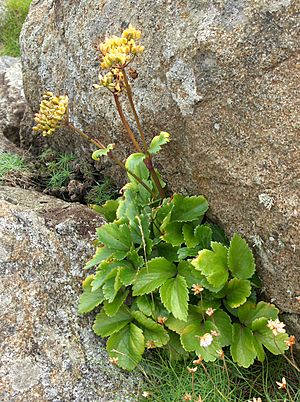Ligusticum scoticum facts for kids
Quick facts for kids Ligusticum scoticum |
|
|---|---|
 |
|
| Scientific classification | |
| Kingdom: | |
| (unranked): | |
| (unranked): | |
| (unranked): | |
| Order: | |
| Family: | |
| Genus: |
Ligusticum
|
| Species: |
L. scoticum
|
| Binomial name | |
| Ligusticum scoticum |
|
| Synonyms | |
|
|
Ligusticum scoticum, also known as Scots lovage or Scottish licorice-root, is a plant that lives for many years. It belongs to the Apiaceae family, which also includes carrots and parsley. You can find this plant growing near the coasts of northern Europe and north-eastern North America. It can grow up to 60 centimeters (about 2 feet) tall. Scots lovage often grows in cracks in rocks and on grassy cliff tops. This plant is edible, and its leaves taste a bit like parsley or celery. Its seeds have a flavor similar to fenugreek or cumin.
Contents
What is Scots Lovage?
Scots lovage is a green plant that grows back every year. It usually reaches a height of 15 to 60 centimeters (6 to 24 inches). Its leaves are shaped like triangles and are divided into smaller sections. Each leaf section is about 2 to 5 centimeters (1 to 2 inches) long. The edges of the leaves can be jagged or wavy. They are usually a lighter green color, but sometimes they can be a bit purple.
The plant's main stem does not branch out much. It has 2 to 5 flower clusters, called umbels. Each cluster is about 4 to 6 centimeters (1.5 to 2.5 inches) wide. The small flowers are greenish-white and about 2 millimeters (0.08 inches) across. The plant's fruits are 4 to 6 millimeters (0.16 to 0.24 inches) long. Each fruit has five clear ridges.
Scots lovage smells and tastes like parsley or celery. In the past, people in western Britain ate it a lot. They used it for food and to help prevent scurvy, a disease caused by not enough vitamin C.
Where Does Scots Lovage Grow?
Scots lovage is mainly an Arctic plant. This means it grows in cold northern regions. You can find it in places like northern Norway and the northern parts of the British Isles. It also grows from western Greenland to New England in North America.
There is a similar plant, Ligusticum hultenii, that grows around the northern Pacific Ocean. This includes areas from Japan to Alaska. Some scientists think L. hultenii might just be a type of L. scoticum. The furthest south L. scoticum is found is in Ballyhalbert in Northern Ireland.
How Does Scots Lovage Live?
In the British Isles, Scots lovage only grows on coasts where the average yearly temperature is below 15°C (59°F). This is probably true for other places where it grows too. In warmer areas, the plant does not grow well on south-facing slopes. It likes to grow in cracks in rocks. Sometimes, it is the only plant growing there. It also grows in grassy areas on top of cliffs.
Scots lovage does not like to be eaten by animals. It is also harmed by nesting seabirds. Because of this, you rarely find it on bird cliffs. You also won't see it where sheep and rabbits graze. However, it can handle salt spray from the ocean. In fact, it grows better when it gets a little bit of sea water.
The leaves of Scots lovage can survive frost. They die back each winter but grow back very quickly in the spring. In the British Isles, the plant flowers from June to August. Its seeds are ready in October or November. In colder places, the flowering and seeding might happen later. Many different pollinators visit the flowers of Scots lovage, especially flies.
Naming Scots Lovage
The plant Ligusticum scoticum was first described by a famous scientist named Carl Linnaeus. He wrote about it in his book Species Plantarum in 1753. Linnaeus first called it scothicum. Many writers in North America still use this spelling. But in Europe, the spelling was changed to scoticum, which is now more common.
Images for kids
See also
 In Spanish: Ligusticum scoticum para niños
In Spanish: Ligusticum scoticum para niños


